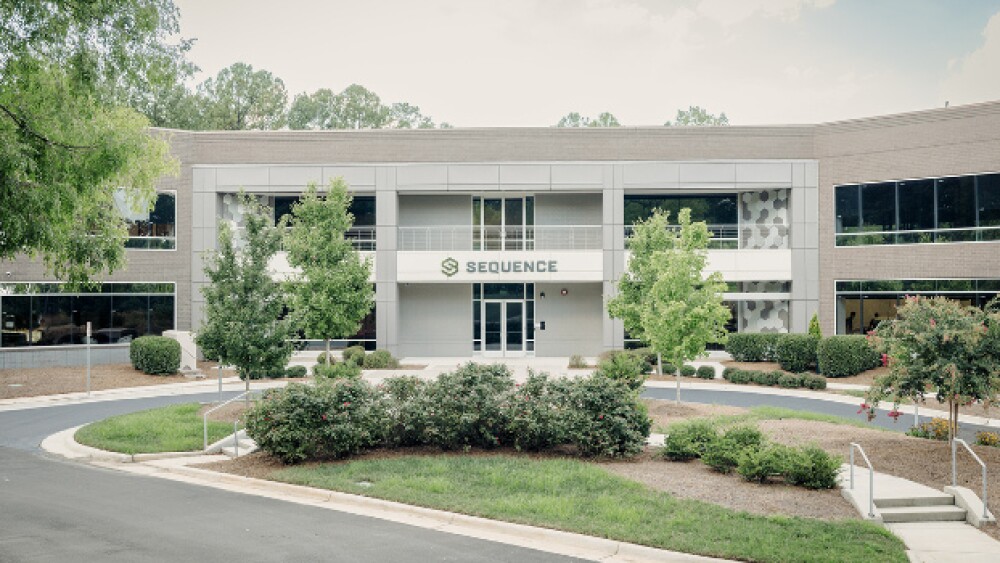Mock facilities can shorten the time it takes to bring new employees up to speed on processes and logistics, as well as allow companies to recruit individuals with limited experience.
Pictured: Sequence’s new training facility/Sequence
Demand for skilled employees in biopharmaceutical manufacturing is outpacing supply, particularly for technicians but also for scientists and engineers. As manufacturers seek to quickly expand capacity, knowledge and experience are urgently needed to efficiently bring new facilities online and run them well.
Infrastructure for training is crucial, John Balchunas, workforce director at the National Institute for Innovation in Manufacturing Biopharmaceuticals (NIIMBL) at the University of Delaware, told BioSpace. “Learning how to operate biopharmaceutical manufacturing unit operations hinges on technical, hands-on skill development and an awareness of the physicality and logistical considerations of a regulated environment.”
A June 2023 report on life sciences workforce trends by TEConomy Partners for the Coalition of State Bioscience Institutes (CSBI) suggested that there is also a broad need for a workforce with skills to adapt to digital transformation.
“Everyone coming into the industry should have some level of understanding of automation and the impacts of digitalization,” Balchunas said. “Technicians, operators, scientists and engineers will need to be able to analyze and interpret data—and more critically, be able to speak to and engage with automation and digitalization-related experts in their organization.”
Hands-On Training
Engineering consultancy Sequence Inc., which supports biopharma companies in process automation and digitalization, among other aspects of pharmaceutical production, recently opened a digitalized mock manufacturing facility as a hands-on training center for its new hires. The facility holds an end-to-end manufacturing process with operable equipment that helps new hires understand how all the parts of a facility are integrated, Justin Cook, vice president of talent management at Sequence, told BioSpace.
Trainees can learn networking and programming principles as well as the skill of contextualizing data. “To incorporate digital functionality into your facility, you need to understand what data to collect to get the answers that you need,” Cook said. “This skillset is often lacking, but our program is designed to develop this cross-functional mindset to be able to build out a digital strategy.”
He added that hands-on training is essential. “Working with real equipment lets trainees connect the dots between theory and application. It’s hard to replace holding pieces in your hands, seeing the materials of construction, and listening for the sound of pumps and motors working effectively or having a problem.”
Sequence is already seeing a boost in the skills and confidence of its trainees who rapidly accelerated their knowledge and experience in a short time through working in the training center, Cook said.
“Under normal circumstances, it can take years to get the exposure to different types of equipment and situations that builds experience,” he said. “We don’t have years.”
In addition to accelerating the training timeline, Cook noted that the new facility allows the company to recruit individuals with less experience. “This training lets us address the workforce shortage issue by soliciting from a larger pool of candidates, including new, inexperienced graduates.”
Beyond the Classroom: Blending the Physical and Virtual
Not far from the Sequence training facility, North Carolina State University’s Biomanufacturing Training and Education Center (BTEC) trains undergraduate and graduate students and biopharma company professionals, including new hires as well as experienced employees. BTEC is working to address the shortage of biopharmaceutical scientists and engineers in the region, which is due in part to demand growth as companies including Eli Lilly and Fujifilm Diosynth have built manufacturing facilities in the area, Jennifer Pancorbo, director of industry programs and research, told BioSpace.
Training time in BTEC’s programs is split about equally between classroom learning and hands-on experience using the equipment in the center. In addition, BTEC’s online courses provide a greater capacity and broader reach to those who are unable to attend in person, Pancorbo said.
“Virtual courses are beneficial for continuous training of existing employees who can learn at their own pace, anytime and anywhere,” she said. “We’ve used techniques for filming equipment to make the virtual experience more immersive, and we find that we can achieve about 85–90% of the desired learning in this virtual setting. The other 10–15% really needs the hands-on, physical experience.”
Emerging digital tools may be able to fill some of this gap. BTEC is exploring how a digital twin—a model of a piece of equipment such as a bioreactor or even of a complete process—would allow students to experiment with process and equipment variables in the software and visualize the results of their actions. “Although it is virtual, it is ‘hands-on’ in a way because it lets you manipulate and see what happens,” Pancorbo said.
Augmented and virtual reality (AR/VR) tools are also finding use across the industry, Balchunas said. At NIIMBL’s recent annual meeting, for example, a demonstration room gave attendees an opportunity to “get a feel for where [AR/VR] technologies can be incorporated into education, professional development and on-the-job training programs,” he noted. “There is interest in seeing how these technologies evolve in the coming years.”
Jennifer Markarian is a freelance writer for the pharmaceutical and chemical industries. She can be reached at technicalwritingsolutions@comcast.net.





